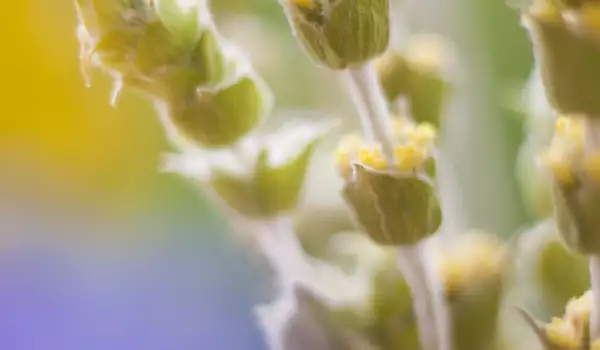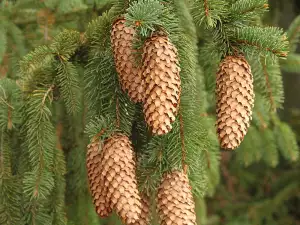Ironwort (Sideritis) is a beautiful perennial herbaceous plant, also known by the names mountain tea and shepherd's tea. Worldwide, the herb is known as Greek tea or Greek mountain tea, since the Greeks were the first to cultivate and sell it.
The rhizomes and stems of ironwort are stiff at their base. The flower-bearing stems are straight or slightly rising, branched or unbranched. They can reach up to 19 3/4″ (50 cm) tall. The leaves of the plant are oppositely arranged, serrated or rounded oval.
The lower ones are long, obtuse, while the upper ones are wide heart-shaped, sessile. The stem at the top is duple, with one part being wider and enveloping the shorter, duller part with its base. The entire plant is covered in fluffy white fibers.
Ironwort blooms from July to September. The inflorescences remain attractive even after overblooming.
The herb is found along dry, rocky, chalky areas. It's resistant to drought and very low temperatures. Ironwort is endemic to the Balkan Peninsula.
The most abundant regions of the herb are found in Bulgaria at about 6068 ft (1850 m) above sea level. Greece, Albania and Macedonia also have several regions of this herb. Due to large-scale picking, the herb is endangered. Picking of the herb has been prohibited by law since 1996 and has been included in the IUCN Red List.
History of Ironwort
The healing properties of ironwort were known to the Greeks back in Antiquity. The ancients believed that the miraculous plant could heal the wounds inflicted by iron weapons. While they were out grazing their sheep, Greek shepherds always carried a bottle of prepared ironwort remedy with them.
Even today, this is the favorite winter drink of the Greeks, having a positive effect on nearly every ailment and especially colds, problems with breathing, digestion, nerves and the immune system.
Types of Ironwort
There is a specially created cultivar of wild ironwort, grown industrially in plantations. There are a few small differences in the appearance of the 2 types.
The wild herb is smaller, with shorter stems, it grows in small bunches and rarely grows taller than 11 3/4″ (30 cm), while the seeds have a very low germination rate - just 10%.
In the wild, the plant thrives in shallow soils, on chalky cliffs and karst topography. The cultivar has longer stems, greater leaf mass and grows in larger bunches.

The selected propagation material to be used for industrial plantation is checked for active substances and only then registered.
Some scientists even believe that the created selection of the cultivated herb has an even greater content of active substances in comparison to the wild plant, the reason for this being the several years of selection of material.
Even though wild ironwort is found at high altitudes above sea level, the cultivar has easily adapted and is grown in lower altitude areas.
Composition of Ironwort
Ironwort contains a whole bunch of healthy substances. Its composition includes flavonoids, phenylpropanoid glycosides, tannins, terpenoids, diterpenes and essential oils, phenols, iridoids, ursolic and oleanolic acid, a number of micronutrients such as iron, copper, zinc, cobalt and selenium, as well as the macronutrients calcium, magnesium, potassium and sodium.
Russian scientists claim that ironwort is similar compositionally to ginseng. It's also thought to contain all of the elements needed for the human body.
Collecting and Storing Ironwort
Ironwort is picked from June to August. The upper parts of the stems, along with the leaves and flowers are used (Herba Silderitis scardcae). The entire above ground part of the herb is picked, with impurities removed.
After cleaning, the collected material is dried in shady, dry and ventilated areas or in a dryer at a temperature no higher than 100°F (35 °C). Every 9 lb (4 kg) of fresh bunches yield 2 lb (1 kg) of dried material. Dried ironwort needs to be stored in dry and ventilated areas, away from other herbs, so they don't take on its aroma.
Benefits of Ironwort
We can write a ton about the benefits of ironwort. Due to the strong presence of flavonoids the herb has an antibacterial and antioxidant effect.
It has antitussive, anti-inflammatory effects and the ability to relieve inflamed mucous membranes. It's recommended for all types of cough, bronchitis, bronchial asthma and more. Thanks to the elements contained in ironwort, it is effective against numerous conditions.
The cobalt, for example, is one of the important elements affecting infertility and potency. The selenium also treats many modern-day diseases, especially tumors, cardiovascular diseases, stress, blood diseases, anemia, depression.
Ironwort provides health and longevity, it slows the aging process of the body. The herb acts as a natural defense against microbes and viruses, relieves inflammation, tones, strengthens, lowers blood pressure, lowers the risk of heart attack and stroke, prevents the development of cancer cells, atherosclerosis and osteoporosis.
The herb improves skin elasticity and smoothness. It also protects against cold and flu, is used to treat liver and kidney diseases, stimulates mental function. Ironwort is the perfect diuretic and filter of toxins in the body.
There are reports that during the 70s of the 20th century, American and Russian astronauts would drink ironwort remedies during their preparation for a flight.
Lately, the plant has become famous as an alternative to viagra because it maintains prostate health in men and provides virility, due to it being a powerful aphrodisiac. Interest in the herb has grown significantly as well. The market for commercial growth of the herb is becoming ever larger. Even Japan and Australia have shown interest toward it in recent years.
Folk Medicine with Ironwort
Folk medicine recommends an ironwort remedy as a cure for any ailment. To make a tea from it, put 1 bunch of the herb to boil for 5 min. in 1 cup (250 ml) water. Then filter it and drink. If desired, sweeten it with sugar or honey. The tea is healthy for adults and children.
You can make the same concoction by breaking up 3-4 bunches of the herb into coarse pieces, putting them in a glass container with a lid and pouring on 1 cup (250 ml) boiling water. Filter the cooled liquid, distribute it into porcelain cups and dilute with water.
The infusion has a slight minty taste. It's recommended not to sweeten it. Optionally, you can combine ironwort with green tea. A beverage prepared this way is exceptionally tonic and refreshing.
If you're not a huge fan of warm teas, you can mix cooled ironwort with a little carbonated water and lemon. This combination will keep you healthy during the summer months.







Comments